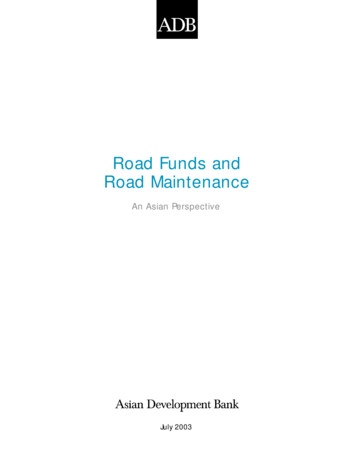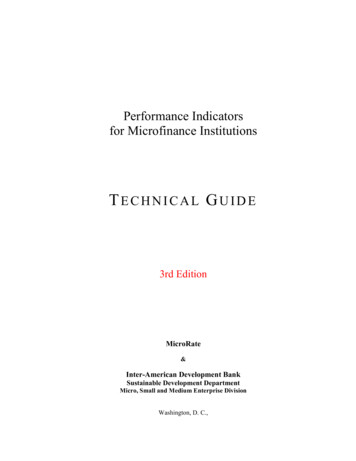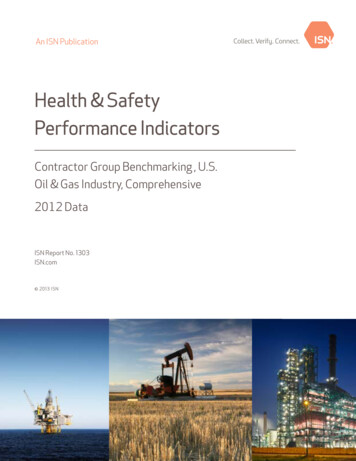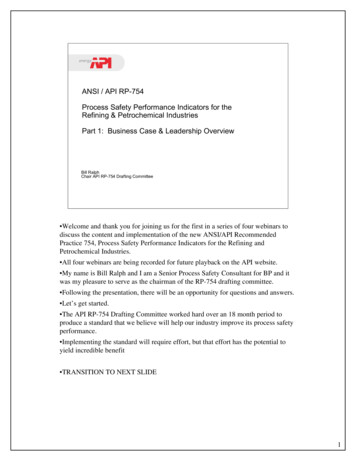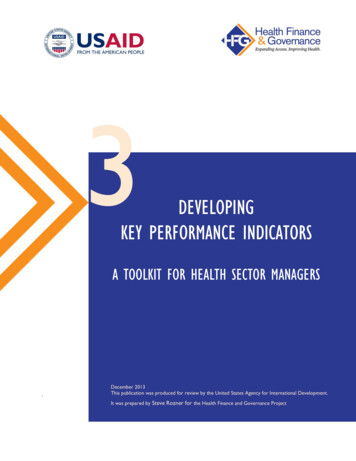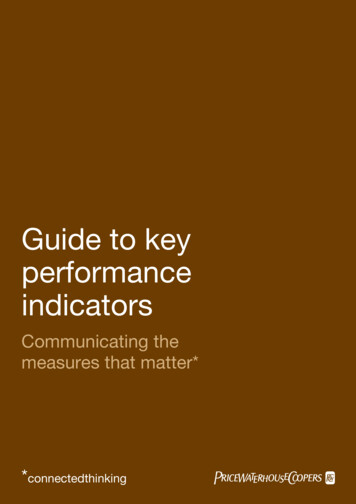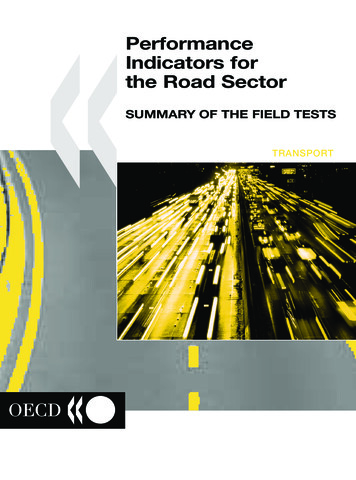
Transcription
«PerformanceIndicators forthe Road SectorSUMMARY OF THE FIELD TESTSTRANSPORT
OECD, 2001. Software: 1987-1996, Acrobat is a trademark of ADOBE.All rights reserved. OECD grants you the right to use one copy of this Program for your personal use only. Unauthorised reproduction,lending, hiring, transmission or distribution of any data or software is prohibited. You must treat the Program and associated materialsand any elements thereof like any other copyrighted material.All requests should be made to:Head of Publications Service,OECD Publications Service,2, rue André-Pascal,75775 Paris Cedex 16, France.
Road Transport and Intermodal ResearchPerformance Indicatorsfor the Road SectorSUMMARY OF THE FIELD TESTSORGANISATION FOR ECONOMIC CO-OPERATION AND DEVELOPMENT
ORGANISATION FOR ECONOMIC CO-OPERATIONAND DEVELOPMENTPursuant to Article 1 of the Convention signed in Paris on 14th December 1960, and which came intoforce on 30th September 1961, the Organisation for Economic Co-operation and Development (OECD)shall promote policies designed:– to achieve the highest sustainable economic growth and employment and a rising standard ofliving in Member countries, while maintaining financial stability, and thus to contribute to thedevelopment of the world economy;– to contribute to sound economic expansion in Member as well as non-member countries in theprocess of economic development; and– to contribute to the expansion of world trade on a multilateral, non-discriminatory basis inaccordance with international obligations.The original Member countries of the OECD are Austria, Belgium, Canada, Denmark, France,Germany, Greece, Iceland, Ireland, Italy, Luxembourg, the Netherlands, Norway, Portugal, Spain,Sweden, Switzerland, Turkey, the United Kingdom and the United States. The following countriesbecame Members subsequently through accession at the dates indicated hereafter: Japan(28th April 1964), Finland (28th January 1969), Australia (7th June 1971), New Zealand (29th May 1973),Mexico (18th May 1994), the Czech Republic (21st December 1995), Hungary (7th May 1996), Poland(22nd November 1996), Korea (12th December 1996) and the Slovak Republic (14th December 2000). TheCommission of the European Communities takes part in the work of the OECD (Article 13 of the OECDConvention).Publié en français sous le titre :INDICATEURS DE PERFORMANCE POUR LE SECTEUR ROUTIERRésumé des essais sur le terrain OECD 2001Permission to reproduce a portion of this work for non-commercial purposes or classroom use should be obtainedthrough the Centre français d’exploitation du droit de copie (CFC), 20, rue des Grands-Augustins, 75006 Paris,France, tel. (33-1) 44 07 47 70, fax (33-1) 46 34 67 19, for every country except the United States. In the United Statespermission should be obtained through the Copyright Clearance Center, Customer Service, (508)750-8400,222 Rosewood Drive, Danvers, MA 01923 USA, or CCC Online: www.copyright.com. All other applications forpermission to reproduce or translate all or part of this book should be made to OECD Publications, 2, rue André-Pascal,75775 Paris Cedex 16, France.
FOREWORDThe Road Transport and Intermodal Linkages Research Programme (RTR) is a co-operativeapproach to transport issues among Member countries of the OECD.The Mission of the RTR Programme is to promote economic development in OECD Membercountries by enhancing transport safety, efficiency and sustainability through a research programmethat recommends options for the development and implementation of effective transport policies forMembers, and that encourages outreach for non-member countries.The research on Performance Indicators for the Roads Sector was initiated in 1995 by a scientificexpert group under the leadership of the RTR Secretariat.A major recommendation of this Group was to create a Taskforce to conduct a co-ordinated set offield tests for selected performance indicators. The Taskforce was established in 1997 with theobjective of refining the indicators selected by the Scientific Expert Group and testing them over aperiod of two years. The field tests would allow the applicability of the performance indicators to beevaluated in order to determine their value in improving the management of road administrations. Thefollowing countries participated in the field test: Australia, Belgium, Denmark, Finland, Hungary,Japan, the Netherlands, New Zealand, Portugal, Sweden, Switzerland, the United Kingdom and theUnited States.3
ABSTRACTITRD N E 108267Following the recommendations of the OECD 1997 report, Performance Indicators for the RoadSector, a task force was established to field test a selection of 15 performance indicators used by roadadministrations throughout the world. The objective of the project was to assess the applicability of theperformance indicators to improving the management of road administration. The field test wasconducted over the period 1997-99 in 15 Member countries. This report outlines the approach adoptedand summarises the results of the field tests.The 15 indicators that were field tested included: average road user costs; level of satisfactionregarding travel time and its reliability and quality of road user information; protected road user risk;unprotected road user risk; environmental policy/programmes; processes in place for market researchand customer feedback; long-term programmes; allocation of resources to road infrastructure; qualitymanagement/audit programmes; forecast values of road costs vs. actual costs; overhead percentage;value of assets; roughness; state of road bridges; satisfaction with road condition.A key aspect of the project was the comparison of the processes in which the indicators are applied bydifferent road administrations. Qualitative assessment on the role of and function served by roadadministrations, and whether the execution of their mandates reflects the views of the public andgovernment, suggested a need cultural change in most cases toward a client focused approach. Thetask force concluded that quantitative comparison between administrations is of limited usefulnessunless it is accompanied by a thorough examination of the underlying reasons for any differences.Field classification:Highway and transport planning; economics and administration.Field codes:21, 10.Key words:Administration, audit, cost, economic efficiency, efficiency, evaluation, highway, measurement,OECD, planning, policy, quality, road construction, road network, road user, surveillance.4
TABLE OF CONTENTSSummary and Conclusions . 7Chapter 1. Introduction . 17Background. 17Selection of the performance indicators. 17Approach. 19Chapter 2. Measurement and Evaluation of Road Administration Performance. 21Generic vision for the road transport system . 21Generic vision for the road administration . 24Case examples. 26Chapter 3. Performance Indicators in a Road Administration. 35Performance indicators and performance measures. 35Selection of the performance indicators. 35How to use the performance indicators. 37Case studies. 40Chapter 4. Field Study . 51PI 1PI 2Average road user cost (car and truck) . 53Level of satisfaction regarding travel time, reliability and quality ofroad-user information. 55PI 3/PI 4 Protected and unprotected road-user risk. 59PI 5Environmental policy/programme . 60PI 6Processes in place for market research and customer feedback. 62PI 7Long-term programmes for construction, maintenance and operations. 64PI 8Allocation of resources to road infrastructure. 65PI 9Quality management audit programme. 69PI 10Forecast values of road costs vs. actual costs . 72PI 11Overhead percentage . 74PI 12Value of assets . 75PI 13Roughness. 77PI 14State of road bridges . 79PI 15Satisfaction with the road system . 80Annex. List of Participants. 83Bibliography. 835
SUMMARY AND CONCLUSIONSThe challenge faced by road administrationsAn emerging challenge for road administrations is to define goals and objectives pertinent tocurrent community views, and to devise creative ways to respond to contemporary problems. Keyissues facing road transport system and road administrations today include: Decreasing road budgets. Demand for greater transparency in road administration performance. Separation of the production and administration roles of road administrations. Adoption of a customer focus rather than an “expert knows best” attitude. Demand for greater efficiency in all operations, leading to better results and quality. Demand for more co-ordination and co-operation across the transport sector. Demand for performance improvements to be implemented more rapidly than in the past. New management aspects and the demand for an open and broad understanding of themobility problems facing society. Demand for more data and more efficient data management.In 1995, the OECD Road Transport Research Programme established a Scientific Expert Groupto investigate Performance Indicators for the Road Sector (OECD, 1997). The report included: asurvey of current methods used by Member countries’ road administrations to assess roadperformance; a set of performance indicators; procedures for refining the performance indicators tomeet the needs of different countries (taking note of available data resources and analyticalprocedures); and a basis for tracking important trends, identifying efficient interventions and makingcountry comparisons.The most important observation from the 1997 report, was that much less emphasis must be puton quantitative analysis, compared to qualitative assessment of the purposes served by the roadprogramme and whether these reflect the views of the public. The objective is to widen the views ofroad managers and planners to reflect the vision of an integrated transport system and the role thatroad administrations play in achieving that vision. In the long term, generic road administrationprocesses could be developed from existing processes, allowing practices to be compared andrecommendations for key rules put forward. This may entail developing common indicators/criteria aswell as a data information network and management system for the OECD countries.7
The 1997 report showed that there is a high level of confidence in the ability of the roadadministrations to deliver, once the deliverables have been identified. The most important outcome ofthe performance indicator review is improved performance through the exchange of experiences, andthe most important finding is the degree of change in response to an intervention. To understanddifferences in performance, the specific context in which the test was performed needs to be described.Comparisons must be made between countries, states and regions, and any recognisable trendsidentified.A Taskforce was to set up a co-ordinated set of field tests for selected performance indicators.The following countries participated in the field tests: Australia, Belgium (Walloon region), Denmark,Finland, Hungary, Japan, the Netherlands, New Zealand, Portugal, Sweden, Switzerland, the UnitedKingdom and the United States (both the Federal Highway Administration and the MinnesotaDepartment of Transportation).Fifteen performance indicators (PI) were tested:PI 1.PI 2.PI 3.PI 4.PI 5.PI 6.PI 7.PI 8.PI 9.PI 10.PI 11.PI 12.PI 13.PI 14.PI 15.Average road user costs.Level of satisfaction regarding travel time and its reliability and quality of road-userinform
performance indicators to improving the management of road administration. The field test was conducted over the period 1997-99 in 15 Member countries. This report outlines the approach adopted and summarises the results of the field tests. The 15 indicators that were field tested included: average road user costs; level of satisfaction

